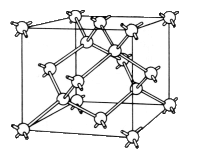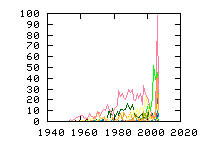« Previous
1
Next »
(20 hits, 1/1)
Showing
10, 25, 50, 100, 500, 1000, all papers per page.
Sort by:
last publication date,
older publication date,
last update date.
- 1. Phys. Rev. B 77, 195204 (2008) , “Identification of antisite carbon split-interstitial defects in 4H-SiC”, J. W. Steeds, W. SullivanA rich variety of optical centers with high energy local vibrational modes has been found in electron-irradiated 4H-SiC in both the as-irradiated and annealed states. These energies have been measured and the annealing dependence of the optical centers has been investigated by low-temperature... (Read more)
- 2. Phys. Rev. B 75, 115205 (2007) , “Stability of I3 complexes in III-V compound semiconductors by tight-binding molecular dynamics”, G. Zollo and F. GalaIntrinsic interstitials in GaAs are known to have a large formation energy that makes their concentration almost negligible in as-grown materials. However, interstitials must be explicitly considered in implanted GaAs where collision cascades, induced by the energetic ions, produce a large amount of... (Read more)
- 3. Phys. Rev. B 75, 085208 (2007) , “Clustering of vacancy defects in high-purity semi-insulating SiC”, R. Aavikko, K. Saarinen, F. Tuomisto, B. Magnusson, N. T. Son, and E. JanzénPositron lifetime spectroscopy was used to study native vacancy defects in semi-insulating silicon carbide. The material is shown to contain (i) vacancy clusters consisting of four to five missing atoms and (ii) Si-vacancy-related negatively charged defects. The total open volume bound to the... (Read more)
- 4. Phys. Rev. Lett. 98, 206406 (2007) , “Role of Intermolecular Coupling in the Photophysics of Disordered Organic Semiconductors: Aggregate Emission in Regioregular Polythiophene”, Jenny Clark, Carlos Silva, Richard H. Friend, and Frank C. SpanoWe address the role of excitonic coupling on the nature of photoexcitations in the conjugated polymer regioregular poly(3-hexylthiophene). By means of temperature-dependent absorption and photoluminescence spectroscopy, we show that optical emission is overwhelmingly dominated by weakly coupled H... (Read more)
- 5. Phys. Rev. Lett. 98, 115503 (2007) , “Oxygen Vacancy Clustering and Electron Localization in Oxygen-Deficient SrTiO3: LDA+U Study”, Do Duc Cuong, Bora Lee, Kyeong Mi Choi, Hyo-Shin Ahn, Seungwu Han, and Jaichan LeeWe find, using a local density approximation +Hubbard U method, that oxygen vacancies tend to cluster in a linear way in SrTiO3, a prototypical perovskite oxide, accompanied by strong electron localization at the 3d state of the nearby Ti transition metal ion. The vacancy... (Read more)
- 6. Appl. Phys. Lett. 89, 012505 (2006) , “Diffusion and clustering of substitutional Mn in (Ga,Mn)As”, Hannes Raebiger, Maria Ganchenkova, and Juhani von BoehmThe Ga vacancy mediated microstructure evolution of (Ga,Mn)As during growth and postgrowth annealing is studied using a multiscale approach. The migration barriers for the Ga vacancies and substitutional Mn together with their interactions are calculated using first principles, and temporal... (Read more)
- 7. J. Appl. Phys. 100, 113519 (2006) , “Void growth during thermal decomposition of silicon oxide layers studied by low-energy electron microscopy”, H. Hibino, M. Uematsu, and Y. WatanabeLow-energy electron microscopy (LEEM) has been used to investigate void growth during thermal decomposition of 1–2-nm-thick silicon oxide on Si substrates. Real-time LEEM observations clarify that the void size (square root of the void area) grows linearly with time. The temperature dependence... (Read more)
- 8. J. Appl. Phys. 100, 113513 (2006) , “Theoretical study of nitrogen-doping effects on void formation processes in silicon crystal growth”, Hiroyuki Kageshima, Akihito Taguchi, and Kazumi WadaNitrogen-doping effects in silicon crystal growth have been theoretically studied using thermodynamical simulation based on first-principles calculation results. The results show that the densities of various complexes are determined in the balance between the enthalpy effects and the entropy... (Read more)
- 9. J. Appl. Phys. 100, 034309 (2006) , “Critical size for defects in nanostructured materials”, Jagdish NarayanThis paper addresses some of the fundamental issues and critical advantages in reducing the grain size/feature size to the nanoscale regime. We find that as the grain size or feature size is reduced, there is a critical size below which the defect content can be reduced virtually to zero. This... (Read more)
- 10. J. Appl. Phys. 99, 073511 (2006) , “Effects of temperature and flux on oxygen bubble formation in Li borosilicate glass under electron beam irradiation”, Nadège Ollier, Giancarlo Rizza, Bruno Boizot, and Guillaume PetiteOxygen bubble formation and evolution under a 300 keV electron beam are analyzed in a Li borosilicate glass under different irradiation conditions: temperature, flux, and dose. Oxygen bubbles are observed to form in a delimited flux and temperature region with a threshold requirement. This region... (Read more)
- 11. J. Appl. Phys. 99, 063513 (2006) , “Superscrew dislocations in silicon carbide: Dissociation, aggregation, and formation”, Xianyun MaAn approach to precisely determine the magnitude and the sign of Burgers vectors of superscrew dislocations (including elementary screw dislocations and micropipes) in silicon carbide (SiC) single crystals has been developed. The histogram of Burgers vector values associated with micropipes follows... (Read more)
- 12. J. Appl. Phys. 99, 043509 (2006) , “Influence of metal trapping on the shape of cavities induced by high energy He+ implantation”, R. El Bouayadi, G. Regula, M. Lancin, B. Pichaud, and M. DesvignesIn He implantation induced cavities highly contaminated with metals (Au, Ni, Pt) we found that, when no three-dimensional structure is observed, the shape of the cavities can be strongly modified depending on the nature of the metal and on its trapped quantity. The equilibrium shape of cavities is... (Read more)
- 13. Phys. Rev. B 74, 174122 (2006) , “Lithium colloids and color center creation in electron-irradiated Li2NH observed by electron-spin resonance”, F. Beuneu, P. Vajda, Y. Nakamori, and S. OrimoWe have irradiated Li2NH powder with MeV electrons at room temperature and investigated the introduced defects with electron spin resonance. Conduction electron spin resonance indicates the presence of nanosize metallic Li colloids seen as a Lorentzian line with a g=2.0023 and a... (Read more)
- 14. Phys. Rev. B 74, 174120 (2006) , “Single-crystal silicon coimplanted by helium and hydrogen: Evolution of decorated vacancylike defects with thermal treatments”, C. Macchi, S. Mariazzi, G. P. Karwasz, R. S. Brusa, P. Folegati, S. Frabboni, and G. OttavianiSi p-type (100) samples were coimplanted at room temperature with He+ ions at 30 keV with a dose of 1×1016 ions/cm2 and successively with H+ ions at 24 keV with a dose of 1×1016 ions/cm2. A series of samples was... (Read more)
- 15. Phys. Rev. B 74, 045217 (2006) , “Vacancy clustering and diffusion in silicon: Kinetic lattice Monte Carlo simulations”, Benjamin P. Haley, Keith M. Beardmore, and Niels Grønbech-JensenDiffusion and clustering of lattice vacancies in silicon as a function of temperature, concentration, and interaction range are investigated by kinetic lattice Monte Carlo simulations. It is found that higher temperatures lead to larger clusters with shorter lifetimes on average, which grow by... (Read more)
- 16. Phys. Rev. B 74, 035205 (2006) , “Mechanisms of arsenic clustering in silicon”, F. F. Komarov, O. I. Velichko, V. A. Dobrushkin, and A. M. MironovA model of arsenic clustering in silicon is proposed and analyzed. The main feature of the proposed model is the assumption that negatively charged arsenic complexes play a dominant role in the clustering process. To confirm this assumption, electron density and concentration of impurity atoms... (Read more)
- 17. Phys. Rev. Lett. 97, 116101 (2006) , “Oxygen Migration, Agglomeration, and Trapping: Key Factors for the Morphology of the Si-SiO2 Interface”, L. Tsetseris and S. T. PantelidesThe measured activation energies for oxide growth rates at the initial and late stages of oxidation of Si are 2 and 1.2 eV, respectively. These values imply that oxidation can proceed at temperatures much smaller than the 800 °C normally used to obtain devices with exceptionally smooth... (Read more)
- 18. Appl. Phys. Lett. 87, 221903 (2005) , “Oxygen segregation to dislocations in GaN”, M. E. Hawkridge and D. ChernsThe structure and composition of threading dislocations in GaN grown by hydride vapor phase epitaxy have been examined by electron microscopy. Transmission electron microscopy showed that the core structure of screw dislocations varied widely, alternating irregularly between open core... (Read more)
- 19. Phys. Rev. B 70, 235211 (2004) , “Structure and vibrational spectra of carbon clusters in SiC”, Alexander Mattausch, Michel Bockstedte, and Oleg PankratovThe electronic, structural, and vibrational properties of small carbon interstitial and antisite clusters are investigated by ab initio methods in 3C- and 4H-SiC. The defects possess sizable dissociation energies and may be formed via condensation of carbon interstitials, e.g.,... (Read more)
- 20. Phys. Rev. B 9, 4351-4361 (1974) , “EPR study of defects in neutron-irradiated silicon: Quenched-in alignment under <110>-uniaxial stress”, Young-Hoon Lee and James W. CorbettThe stress effect in an EPR study is first treated rigorously in terms of the piezospectroscopic tensor, taking account of the local symmetry of a defect. It is found that the degree of alignment (n?/n?) provides incisive information on the structure of a defect; in general, a... (Read more)
« Previous
1
Next »
(20 hits, 1/1)
Showing
10, 25, 50, 100, 500, 1000, all papers per page.
Sort by:
last publication date,
older publication date,
last update date.
All papers (3399)
Updated at 2010-07-20 16:50:39
Updated at 2010-07-20 16:50:39
(view as: tree
,
cloud
)
| 1329 | untagged |
Materials
(111 tags)
Others(101 tags)
Technique
(46 tags)
Details
(591 tags)
Bond(35 tags)
Defect(interstitial)(18 tags)
Defect(vacancy)(15 tags)
Defect-type(19 tags)
Element(65 tags)
Energy(8 tags)
Isotope(56 tags)
Label(303 tags)
Sample(17 tags)
Spin(8 tags)
Symmetry(15 tags)

